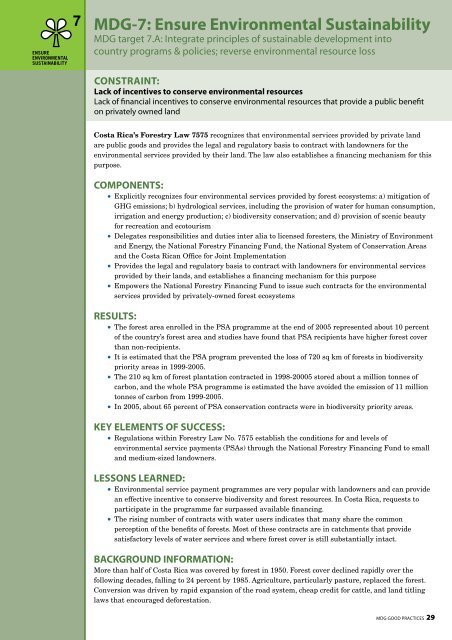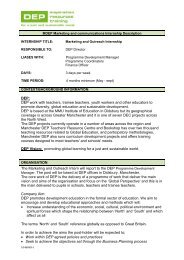Download - United Nations in Cambodia
Download - United Nations in Cambodia
Download - United Nations in Cambodia
- No tags were found...
You also want an ePaper? Increase the reach of your titles
YUMPU automatically turns print PDFs into web optimized ePapers that Google loves.
MDG-7: Ensure Environmental Susta<strong>in</strong>abilityMDG target 7.A: Integrate pr<strong>in</strong>ciples of susta<strong>in</strong>able development <strong>in</strong>tocountry programs & policies; reverse environmental resource lossConstra<strong>in</strong>t:Lack of <strong>in</strong>centives to conserve environmental resourcesLack of f<strong>in</strong>ancial <strong>in</strong>centives to conserve environmental resources that provide a public benefiton privately owned landCosta Rica’s Forestry Law 7575 recognizes that environmental services provided by private landare public goods and provides the legal and regulatory basis to contract with landowners for theenvironmental services provided by their land. The law also establishes a f<strong>in</strong>anc<strong>in</strong>g mechanism for thispurpose.Components:• Explicitly recognizes four environmental services provided by forest ecosystems: a) mitigation ofGHG emissions; b) hydrological services, <strong>in</strong>clud<strong>in</strong>g the provision of water for human consumption,irrigation and energy production; c) biodiversity conservation; and d) provision of scenic beautyfor recreation and ecotourism• Delegates responsibilities and duties <strong>in</strong>ter alia to licensed foresters, the M<strong>in</strong>istry of Environmentand Energy, the National Forestry F<strong>in</strong>anc<strong>in</strong>g Fund, the National System of Conservation Areasand the Costa Rican Office for Jo<strong>in</strong>t Implementation• Provides the legal and regulatory basis to contract with landowners for environmental servicesprovided by their lands, and establishes a f<strong>in</strong>anc<strong>in</strong>g mechanism for this purpose• Empowers the National Forestry F<strong>in</strong>anc<strong>in</strong>g Fund to issue such contracts for the environmentalservices provided by privately-owned forest ecosystemsResults:• The forest area enrolled <strong>in</strong> the PSA programme at the end of 2005 represented about 10 percentof the country’s forest area and studies have found that PSA recipients have higher forest coverthan non-recipients.• It is estimated that the PSA program prevented the loss of 720 sq km of forests <strong>in</strong> biodiversitypriority areas <strong>in</strong> 1999-2005.• The 210 sq km of forest plantation contracted <strong>in</strong> 1998-20005 stored about a million tonnes ofcarbon, and the whole PSA programme is estimated the have avoided the emission of 11 milliontonnes of carbon from 1999-2005.• In 2005, about 65 percent of PSA conservation contracts were <strong>in</strong> biodiversity priority areas.Key Elements of Success:• Regulations with<strong>in</strong> Forestry Law No. 7575 establish the conditions for and levels ofenvironmental service payments (PSAs) through the National Forestry F<strong>in</strong>anc<strong>in</strong>g Fund to smalland medium-sized landowners.Lessons Learned:• Environmental service payment programmes are very popular with landowners and can providean effective <strong>in</strong>centive to conserve biodiversity and forest resources. In Costa Rica, requests toparticipate <strong>in</strong> the programme far surpassed available f<strong>in</strong>anc<strong>in</strong>g.• The ris<strong>in</strong>g number of contracts with water users <strong>in</strong>dicates that many share the commonperception of the benefits of forests. Most of these contracts are <strong>in</strong> catchments that providesatisfactory levels of water services and where forest cover is still substantially <strong>in</strong>tact.Background Information:More than half of Costa Rica was covered by forest <strong>in</strong> 1950. Forest cover decl<strong>in</strong>ed rapidly over thefollow<strong>in</strong>g decades, fall<strong>in</strong>g to 24 percent by 1985. Agriculture, particularly pasture, replaced the forest.Conversion was driven by rapid expansion of the road system, cheap credit for cattle, and land titl<strong>in</strong>glaws that encouraged deforestation.MDG Good Practices 29








